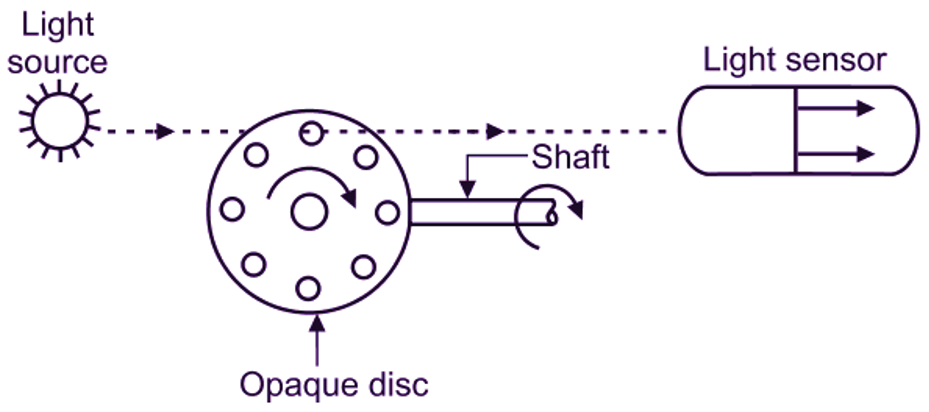Range: Up to 10000 r.p.m.
Construction of Photoelectric Tachometer
Photoelectric Tachometer uses an opaque disc having equidistant holes on its periphery. This disc is mounted on a rotating shaft, whose speed is to be measured. A light source is placed on one side of the disc and a light sensor is placed on the other side. The light sensor may be photosensitive device or photo tube. The light sensor must be in line with the light source.

Fig. 1: Photoelectric Tachometer
Working of Photoelectric Tachometer
On rotation of disc, holes and opaque portions of the disc come alternatively in between light source and light sensor (Receiver). Thus, whenever a hole comes in line with light source and sensor, a pulse is generated. Refer Fig. 2. The frequency of these pulses depends upon
- Number of holes on discs and
- Speed of rotation of disc.
Here, Speed,
\[\text{N}=\frac{\text{f}}{\text{H}}\]
Where, f = frequency, and H = Number of holes.
When the opaque portion of disc is in between the light source and light sensor, no light falls on the sensor and therefore, no output results are obtained. Since the number of holes are fixed, therefore, the number of pulses are counted or measured by means of an electric counter, which is a measure of speed of shaft. It is calibrated directly to give speed of shaft in r.p.m.

Fig. 2: Simple Arrangement of Photoelectric Tachometer
Advantages of Photoelectric Tachometer
- Simple in construction.
- Output is in digital form, so accuracy is more.
- Easy to operate and understand.
- Used to measure very high speed.
- Less maintenance.
- It is contactless method.
Disadvantages of Photoelectric Tachometer
- As the life of light source is short, it needs to be replaced periodically.
- Less accurate.
Applications of Photoelectric Tachometer
- Photoelectric tachometer is used to measure the speed upto 10,000 r.p.m.
- For speed measurement of motors.